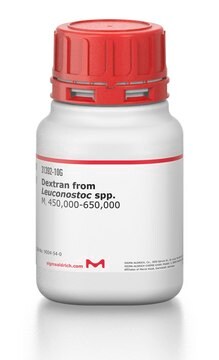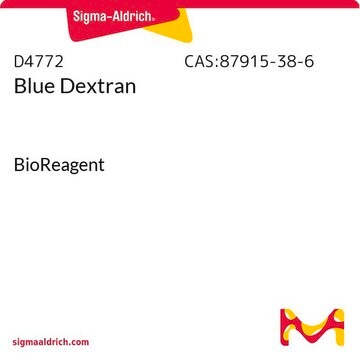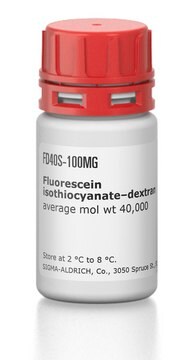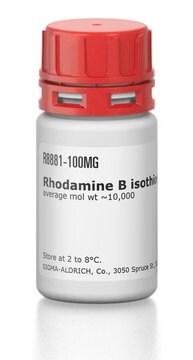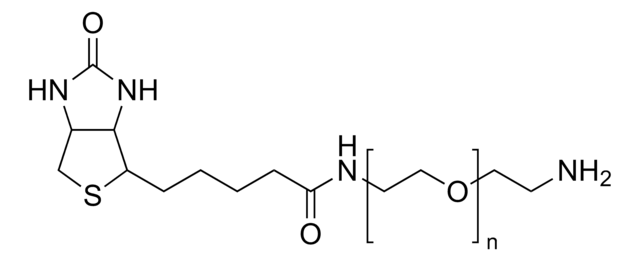B9139
Biotin-dextran
mol wt 10,000, Lysine-fixable
Autenticatiper visualizzare i prezzi riservati alla tua organizzazione & contrattuali
About This Item
Prodotti consigliati
Coniugato
biotin conjugate
Livello qualitativo
Stato
powder
PM
10,000
Grado di funzionalizzazione
~2 mol per mol
Colore
white
Solubilità
H2O: soluble 50 mg/mL, clear, colorless to faintly yellow
Temperatura di conservazione
2-8°C
Cerchi prodotti simili? Visita Guida al confronto tra prodotti
Applicazioni
Biotin-dextran is used in tissue staining to prepare neurons for detection by avidin-conjugated detection systems. It is taken up by neuronal processes and transported bi-directionally. It infiltrates axon boutons in the anterograde direction and dendritic processes in the retrograde direction. Staining can be observed in fixed and sectioned tissue from two days to two weeks after biotin-dextran is injected into the brain or spinal cord. It can also be applied to cut nerve tracts. Biotinylated neurons are detected by either light or electron microscopy following incubation with avidin-horseradish peroxidase conjugate and the electron-dense substrate 3,3′-diaminobenzidine (DAB).
Altre note
To gain a comprehensive understanding of our extensive range of Dextrans for your research, we encourage you to visit our Carbohydrates Category page.
Codice della classe di stoccaggio
11 - Combustible Solids
Classe di pericolosità dell'acqua (WGK)
WGK 3
Punto d’infiammabilità (°F)
Not applicable
Punto d’infiammabilità (°C)
Not applicable
Dispositivi di protezione individuale
Eyeshields, Gloves, type N95 (US)
Scegli una delle versioni più recenti:
Certificati d'analisi (COA)
Lot/Batch Number
Non trovi la versione di tuo interesse?
Se hai bisogno di una versione specifica, puoi cercare il certificato tramite il numero di lotto.
Possiedi già questo prodotto?
I documenti relativi ai prodotti acquistati recentemente sono disponibili nell’Archivio dei documenti.
I clienti hanno visto anche
C Brösamle et al.
Journal of neurocytology, 29(7), 499-507 (2001-03-30)
The corticospinal tract (CST) of the rat is a widely used model system in developmental, physiological, and regeneration studies. The CST of the rat consists of a main tract, that runs in the dorsomedial funiculus and several minor components. We
Karen M Fisher et al.
The Journal of comparative neurology, 526(15), 2373-2387 (2018-07-18)
The corticospinal tract (CST) forms the major descending pathway mediating voluntary hand movements in primates, and originates from ∼nine cortical subdivisions in the macaque. While the terminals of spared motor CST axons are known to sprout locally within the cord
Giam S Vega-Meléndez et al.
Journal of neuroscience research, 92(1), 13-23 (2013-10-30)
Neurotrophins such as ciliary neurotrophic factor (CNTF) and brain-derived neurotrophic factor (BDNF) and growth factors such as fibroblast growth factor (FGF-2) play important roles in neuronal survival and in axonal outgrowth during development. However, whether they can modulate regeneration after
Jia Liu et al.
Journal of the neurological sciences, 325(1-2), 127-136 (2013-01-16)
The stem cell-based experimental therapies are partially successful for the recovery of spinal cord injury (SCI). Recently, acellular spinal cord (ASC) scaffolds which mimic native extracellular matrix (ECM) have been successfully prepared. This study aimed at investigating whether the spinal
Prefrontal cortical inputs to the basal amygdala undergo pruning during late adolescence in the rat.
Victoria L Cressman et al.
The Journal of comparative neurology, 518(14), 2693-2709 (2010-05-28)
Transformations in affective and social behaviors, many of which involve amygdalar circuits, are hallmarks of adolescence in many mammalian species. In this study, using the rat as a model, we provide the first evidence that afferents of the basal amygdala
Il team dei nostri ricercatori vanta grande esperienza in tutte le aree della ricerca quali Life Science, scienza dei materiali, sintesi chimica, cromatografia, discipline analitiche, ecc..
Contatta l'Assistenza Tecnica.
